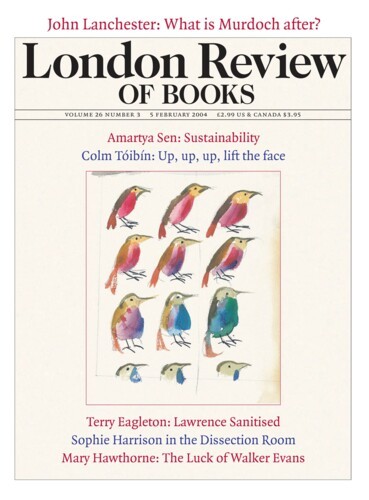‘This is a work of fiction. All characters and events are the product of the author’s imagination. Any resemblance to real persons, living or dead, is entirely coincidental.’ There seem to be innumerable subtle variations of the formula. There is also, no doubt, a way of determining which books require the disclaimer and which don’t, but what the rule might be is a puzzle. Presumably, some novels don’t need to defend themselves in this way because there’s no chance of anyone mistaking any of the characters for real people or any of the events for things that might actually have happened.
Conversely, the disclaimer may instantly arouse suspicions in a certain kind of reader: surely you need to deny that your characters are portraits of real people only if that’s precisely what they are. It seems slightly foolish, therefore, to draw attention to yourself with protestations of innocence which anyway aren’t going to save you – nobody ever got off simply by pleading not guilty. Then again, what is it that the author needs to be saved from? Writing a novel with characters based on real people isn’t intrinsically libellous; and if libel were the issue, there’d be no reason to include the dead among the unresembled, since you can (legally, at least) say what-ever the hell you like about them. As a safeguard against the retaliations of the misrepresented living, meanwhile, you can probably rely on their vanity, or else their sense of shame: either they won’t recognise themselves in your unflattering portrayal, or they’ll be too embarrassed to own up to it. In the words of Lee Smith, the author of Fair and Tender Ladies and, most recently, The Last Girls: ‘It’s easy to disguise them enough for the purposes of putting them in a novel – just add a moustache, or change their sex or move them to Arizona . . . They’ll never know.’
The disclaimer may, however, have nothing to do with the law, or with minding people’s feelings. Perhaps it isn’t so much a disclaimer as a claim, an assertion of artistic purity: this is a work of fiction, all the characters have sprung from my mind fully-formed, like Athena from the head of Zeus – no grubby couplings with reality here. Or maybe it’s a pre-emptive brush-off, the formal equivalent of Kurt Vonnegut’s reply when asked where he got his characters from: ‘Cincinnati,’ he said.
This anecdote, like the quotation from Smith, is one of the many in ‘Madame Bovary, c’est moi’: The Great Characters of Literature and Where They Came From by André Bernard (Norton, $19.95). Literary models don’t get much more famous than the Delamare case: in that (obvious) sense, the pronouncement of Flaubert’s which Bernard takes for his title is transparently absurd. In another (no less obvious) sense, however, Flaubert couldn’t be more right: what makes his heroine Emma Bovary rather than Delphine Delamare, c’est lui. Writers must get tired of answering crass questions – and not only writers. Bob Dylan, when asked by a journalist what his songs were ‘about’, said: ‘Some of my songs are about four minutes, some are about five minutes and some, believe it or not, are about eleven or twelve.’
Bernard’s book is organised alphabetically, according to characters’ first names: Godot comes after George Smiley. There are several apocryphal stories about where Beckett got the name from. One is that he was in a town through which the Tour de France had recently passed, and came across a group of people standing expectantly on a street corner long after the cyclists had disappeared. He asked them what they were doing. ‘Nous attendons Godot,’ they replied, explaining that Godot was the oldest and slowest competitor in the race. Beckett is also supposed to have come up with the idea for the play while waiting for a bus in Roussillon during World War Two. Another alleged inspiration is the rue Godot de Mauroy in Paris, where, the story goes, Beckett – again, waiting for a bus – was approached by a prostitute. When he turned her down, she asked him who he was saving himself for, Godot? And so indefinitely, and not inappropriately, on.
Lots of women claimed to have been the original of Holly Golightly. The strongest contenders were Pamela Drake and Doris Lilly, who ‘were living in this brownstone walk-up on East 78th St, exactly the one in Breakfast at Tiffany’s. Exactly. Truman used to come over all the time and watch me put make-up on before I went out,’ Lilly, the author of How to Marry a Millionaire, later said. A woman called Golightly sued Capote (‘for a fortune’, according to Bernard, though he doesn’t say whether or not she won). Capote said her case was about as plausible as Joan Crawford claiming to be the model for Lolita. A more clinching argument might have been to point out that not only is ‘Holly Golightly’ an assumed name in the novella, but that the pseudonym was originally going to be ‘Connie Gustafson’. Or perhaps he could have reminded her that Breakfast at Tiffany’s is a work of fiction, and any resemblance to real persons, living or dead, is entirely coincidental. Like, duh.
Send Letters To:
The Editor
London Review of Books,
28 Little Russell Street
London, WC1A 2HN
letters@lrb.co.uk
Please include name, address, and a telephone number.

